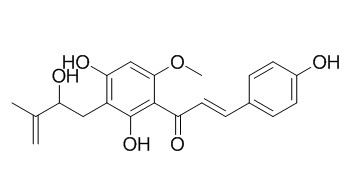Xanthohumol D
Xanthohumol and xanthohumol D are potent inducers of quinone reductase, suggests that they could be used as chemoprevention agents.
Inquire / Order:
manager@chemfaces.com
Technical Inquiries:
service@chemfaces.com
Tel:
+86-27-84237783
Fax:
+86-27-84254680
Address:
1 Building, No. 83, CheCheng Rd., Wuhan Economic and Technological Development Zone, Wuhan, Hubei 430056, PRC
Providing storage is as stated on the product vial and the vial is kept tightly sealed, the product can be stored for up to
24 months(2-8C).
Wherever possible, you should prepare and use solutions on the same day. However, if you need to make up stock solutions in advance, we recommend that you store the solution as aliquots in tightly sealed vials at -20C. Generally, these will be useable for up to two weeks. Before use, and prior to opening the vial we recommend that you allow your product to equilibrate to room temperature for at least 1 hour.
Need more advice on solubility, usage and handling? Please email to: service@chemfaces.com
The packaging of the product may have turned upside down during transportation, resulting in the natural compounds adhering to the neck or cap of the vial. take the vial out of its packaging and gently shake to let the compounds fall to the bottom of the vial. for liquid products, centrifuge at 200-500 RPM to gather the liquid at the bottom of the vial. try to avoid loss or contamination during handling.
J Cell Mol Med.2022, 26(23):5807-5819.
Anal Sci.2019, 35(12):1317-1325
Lab Chip.2018, 18(6):971-978
Natural Product Res.&Deve.2022, 1001-6880.
Antioxidants (Basel).2021, 10(3):379.
Fitoterapia.2015, 100:179-86
Indian J. of Experimental Bio.2020, 9(58).
Molecules.2023, 28(2):727.
Adaptive Medicine 2020, 12(1): 4-10
South African Journal of Botany2024, 168:209-220.
Related and Featured Products
Bioorg Med Chem. 2013 Apr 1;21(7):2001-6.
Fungal metabolites of xanthohumol with potent antiproliferative activity on human cancer cell lines in vitro.[Pubmed:
23434138]
Xanthohumol (1) and Xanthohumol D (2) were isolated from spent hops. Isoxanthohumol (3) was obtained from xanthohumol by isomerisation in alkaline solution.
METHODS AND RESULTS:
Six metabolites were obtained as a result of transformation of xanthohumol (1) by selected fungal cultures.
Their structures were established on the basis of their spectral data. One of them: 2″-(2'''-hydroxyisopropyl)-dihydrofurano-[4″,5″:3',4']-4',2-dihydroxy-6'-methoxy-α,β-dihydrochalcone (6) has not been previously reported in the literature. The antioxidant properties of hops flavonoids and Xanthohumol Derivatives were investigated using the 2,2'-diphenyl-1-picrylhydrazyl (DPPH) radical scavenging method. The effects of these compounds on proliferation of MCF-7, PC-3 and HT-29 human cancer cell lines were determined by the SRB assay.
CONCLUSIONS:
With the exception of one metabolite, all tested compounds showed antiproliferative activity against the tested human cancer lines. α,β-Dihydroxanthohumol (4), obtained through the biotransformation of xanthohumol, showed higher antiproliferative activity against MCF-7 human breast carcinoma cell line than cisplatin, a widely used anticancer therapeutic agent, and a comparably high activity against PC-3 human prostate cancer cell line.
Anal Chem. 2005 Oct 1;77(19):6407-14.
Screening method for the discovery of potential cancer chemoprevention agents based on mass spectrometric detection of alkylated Keap1.[Pubmed:
16194107]
Natural products are important sources of drugs such as cancer chemopreventive agents, but most assays for the discovery of compounds in natural product extracts are low throughput and provide little information about lead compounds in these complex mixtures. The induction of enzymes such as quinone reductase, glucuronyl transferases, glutathione S-transferases, and sulfotransferases can protect cells against the toxic and neoplastic effects of carcinogens. An increase in the concentration of Nrf2 in the nucleus of a cell upregulates the antioxidant response element and induces the expression of these chemopreventive enzymes.
METHODS AND RESULTS:
Based on the hypothesis that ubiquitination and proteosome-mediated degradation of Nrf2 in the cytoplasm decreases upon the covalent modification of 1 or more of the 27 cysteine sulfhydryl groups on Keap1 (a protein that sequesters Nrf2 in the cytoplasm) and results in higher Nrf2 levels both in the cytoplasm and in the nucleus, a high-throughput mass spectrometry-based screening assay was designed to detect alkylation of sulfhydryl groups of human Keap1. As an initial high-throughput screening step, matrix-assisted laser desorption time-of-flight mass spectrometry was used to determine whether incubation of Keap1 with a botanical sample produced adducts of Keap1. Test extracts found to form adducts with Keap1 were then incubated with the alternative biological nucleophile glutathione and characterized using LC-UV-MS-MS. After validation of the assay using two model alkylating agents, fractions of an extract of hops (Humulus lupulus L.) from the brewing industry were screened, and several compounds were detected as potential chemopreventive agents.
CONCLUSIONS:
Two of these electrophilic hops constituents were identified as xanthohumol and Xanthohumol D. In a subsequent cell-based assay, xanthohumol and Xanthohumol D were confirmed to be potent inducers of quinone reductase, and reaction with Keap1 was also confirmed. Therefore, this new mass spectrometric screening assay was demonstrated to facilitate the discovery of chemoprevention agents in complex natural product mixtures.



